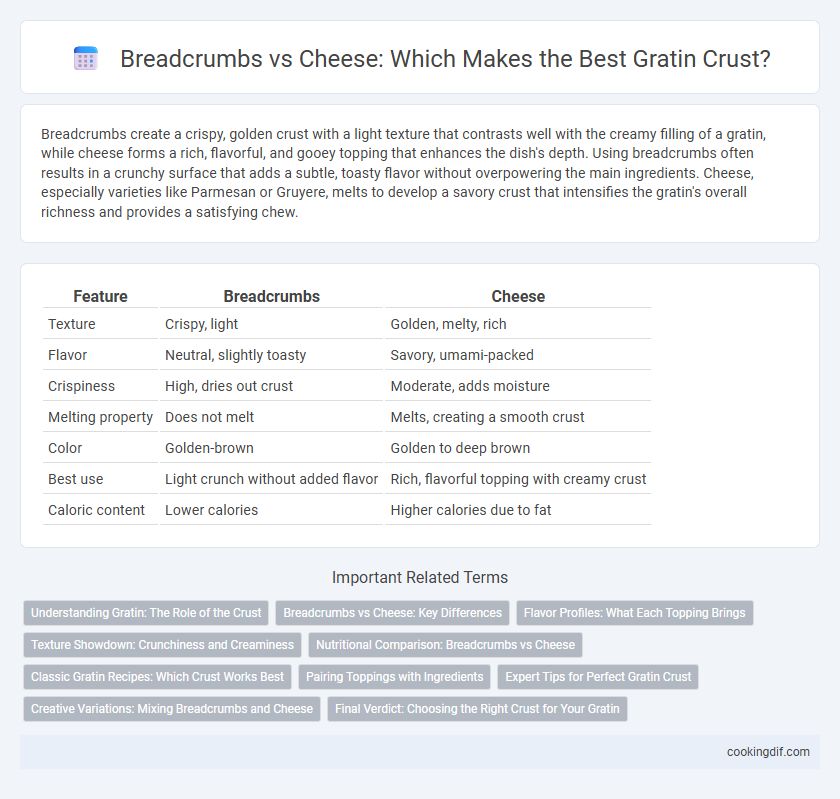Breadcrumbs create a crispy, golden crust with a light texture that contrasts well with the creamy filling of a gratin, while cheese forms a rich, flavorful, and gooey topping that enhances the dish's depth. Using breadcrumbs often results in a crunchy surface that adds a subtle, toasty flavor without overpowering the main ingredients. Cheese, especially varieties like Parmesan or Gruyere, melts to develop a savory crust that intensifies the gratin's overall richness and provides a satisfying chew.
Table of Comparison
| Feature | Breadcrumbs | Cheese |
|---|---|---|
| Texture | Crispy, light | Golden, melty, rich |
| Flavor | Neutral, slightly toasty | Savory, umami-packed |
| Crispiness | High, dries out crust | Moderate, adds moisture |
| Melting property | Does not melt | Melts, creating a smooth crust |
| Color | Golden-brown | Golden to deep brown |
| Best use | Light crunch without added flavor | Rich, flavorful topping with creamy crust |
| Caloric content | Lower calories | Higher calories due to fat |
Understanding Gratin: The Role of the Crust
In gratins, the crust serves both texture and flavor enhancement, with breadcrumbs creating a crispy, golden layer that absorbs butter and seasonings for a crunchy contrast. Cheese, often Gruyere or Parmesan, melts into a bubbly, savory crust that adds richness and depth of flavor through caramelization. Choosing between breadcrumbs and cheese for a gratin crust depends on desired texture--light and crisp versus creamy and gooey--and the specific dish's flavor profile.
Breadcrumbs vs Cheese: Key Differences
Breadcrumbs create a light, crispy crust by absorbing moisture and browning evenly, while cheese forms a rich, golden, bubbly layer that adds creamy texture and intense flavor. Breadcrumbs provide a subtle crunch without overpowering the dish, ideal for delicate gratins, whereas cheese offers a savory depth that enhances heartier recipes. The choice between breadcrumbs and cheese depends on desired crust texture and flavor intensity in gratin preparation.
Flavor Profiles: What Each Topping Brings
Breadcrumbs create a crunchy, golden crust with a subtle, nutty flavor that enhances the dish's texture without overpowering the main ingredients. Cheese forms a rich, creamy, and savory topping that melts into a bubbly, caramelized layer, adding depth and umami complexity to the gratin. Combining both toppings balances crispiness and cheesiness, elevating the overall flavor profile with contrasting textures and intensified savory notes.
Texture Showdown: Crunchiness and Creaminess
Breadcrumbs create a golden, crunchy crust that adds a satisfying crisp texture to gratin dishes, perfect for contrast against soft interiors. Cheese melts into a rich, creamy layer, offering smoothness and a gooey consistency that enhances the dish's luscious mouthfeel. Choosing between breadcrumbs and cheese depends on whether you prefer a crunchy bite or a creamy, velvety crust texture in your gratin.
Nutritional Comparison: Breadcrumbs vs Cheese
Breadcrumbs provide a lower-calorie, higher-fiber crust option rich in carbohydrates and some micronutrients like iron and B vitamins, enhancing digestive health. Cheese crusts offer higher protein and fat content, especially calcium and vitamin A, contributing to bone strength but increasing saturated fat intake. Choosing between breadcrumbs and cheese depends on dietary goals: breadcrumbs favor weight management and fiber intake, while cheese supports protein and calcium requirements.
Classic Gratin Recipes: Which Crust Works Best
Classic gratin recipes often debate the choice between breadcrumbs and cheese for the crust, with breadcrumbs providing a crisp, golden texture that contrasts the creamy interior. Cheese crusts, particularly Gruyere or Parmesan, offer a rich, savory depth and a slightly gooey topping that enhances flavor complexity. Breadcrumbs excel in creating a light, crunchy layer, while cheese contributes both texture and umami, making the best crust choice dependent on the desired balance of crispiness and richness.
Pairing Toppings with Ingredients
Breadcrumbs provide a crispy, golden crust that enhances the texture of gratin dishes, especially when paired with creamy ingredients like potatoes or cauliflower. Cheese crusts create a rich, savory topping that complements vegetables such as zucchini or eggplant, adding depth through melted, browned flavors. Combining both breadcrumbs and cheese results in a balanced topping that offers crunch and gooeyness, perfect for layered gratins featuring meats or robust vegetables.
Expert Tips for Perfect Gratin Crust
For a perfectly golden gratin crust, combining breadcrumbs and cheese creates an ideal balance of texture and flavor, with breadcrumbs providing crispiness and cheese adding rich, savory notes. Experts recommend using freshly grated Parmesan or Gruyere cheese mixed with panko breadcrumbs to achieve a crunchy yet melty topping that enhances the gratin's overall appeal. Applying a light brush of butter or olive oil on top before baking ensures the crust browns evenly without burning.
Creative Variations: Mixing Breadcrumbs and Cheese
Combining breadcrumbs and cheese in a gratin crust creates a balanced texture that is both crispy and savory, enhancing the overall flavor profile. Mixing Parmesan or Gruyere with panko breadcrumbs delivers a golden, crunchy topping while adding rich, umami notes. This creative variation allows for customization by adjusting ratios and incorporating herbs or spices, elevating traditional gratin dishes.
Final Verdict: Choosing the Right Crust for Your Gratin
Breadcrumbs create a crisp, golden crust that adds a satisfying texture contrast to the creamy interior of a gratin, enhancing each bite with a light crunch. Cheese forms a rich, bubbly crust that intensifies flavor through caramelization and delivers a luscious, savory finish that melds seamlessly with the dish. Choosing between breadcrumbs and cheese depends on whether a gratin benefits from a delicate crunch or a robust, cheesy top layer tailored to your flavor profile.
Breadcrumbs vs Cheese for crust Infographic

 cookingdif.com
cookingdif.com